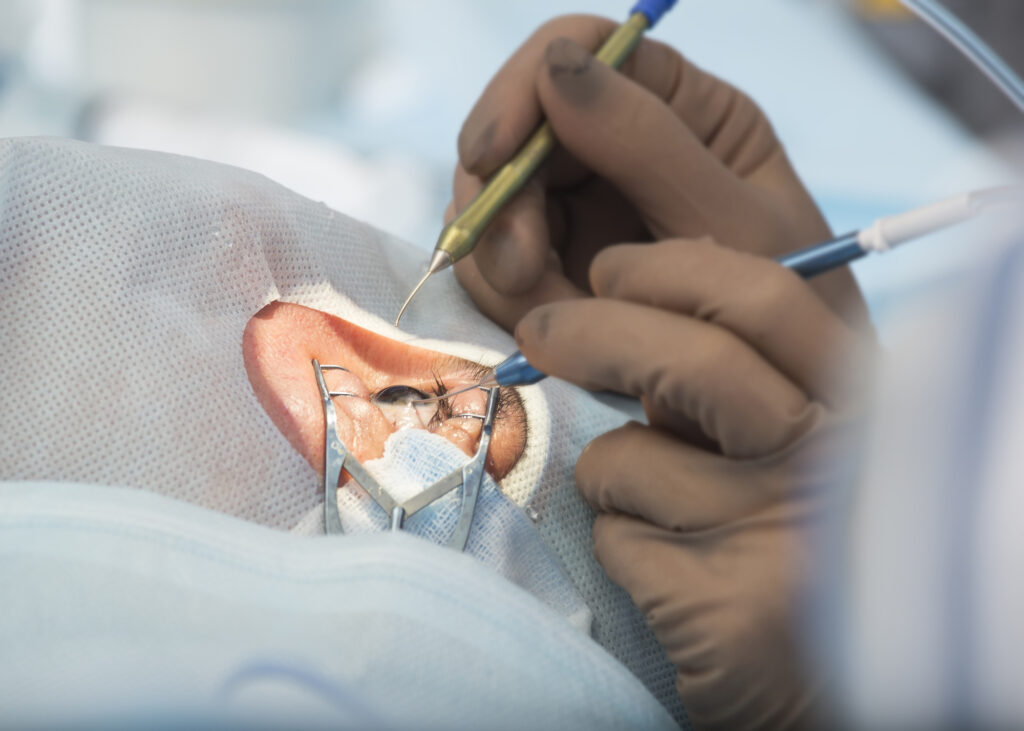If you have been experiencing cloudy or blurry vision, you may be suffering from cataracts. Cataracts are a common eye condition that can significantly impair your vision and quality of life. The good news is that cataract eye surgery can help restore your vision and improve your overall well-being. In this article, we will dive deep into the world of cataracts, exploring their causes, the science behind cataract surgery, the benefits it provides, and how to prepare for the procedure. We will also discuss the post-surgery care and recovery process to ensure optimal results.
Understanding Cataracts
What are Cataracts?
Before we delve into cataract eye surgery, it is essential to understand what cataracts are. Cataracts are a clouding of the lens in your eye, which leads to a decrease in vision. This clouding occurs as a result of proteins in the lens clumping together and forming a dense mass. Over time, cataracts can become denser, making it harder for light to pass through and resulting in a significant decline in vision quality.
Cataracts can manifest in various forms, affecting different parts of the lens. Subcapsular cataracts develop at the back of the lens, often in individuals with diabetes or those taking high doses of steroid medications. Nuclear cataracts form in the center of the lens and are commonly associated with aging. Cortical cataracts, which occur in the lens cortex, have unique spoke-like opacities that can interfere with light perception.

Causes and Risk Factors of Cataracts
There are several factors that can contribute to the development of cataracts. Age is one of the primary risk factors, with cataracts commonly occurring in individuals over the age of 60. Other risk factors include prolonged exposure to ultraviolet (UV) radiation, diabetes, smoking, and certain medications. Additionally, genetics and a family history of cataracts can increase your likelihood of developing the condition.
UV radiation, whether from the sun or artificial sources like tanning beds, can accelerate cataract formation by damaging the proteins in the lens. Diabetes, especially when poorly controlled, can lead to the accumulation of sugar molecules on the lens, causing clouding and vision impairment. Smoking not only increases the risk of cataracts but also worsens their progression. Certain medications, such as corticosteroids and diuretics, have been linked to cataract development due to their impact on the eye’s structure and function.
The Science Behind Cataract Eye Surgery
The Anatomy of the Eye
Before we delve into the fascinating world of cataract surgery, let’s take a moment to appreciate the intricate anatomy of the eye. The eye is a marvel of biological engineering, comprising various structures that work in harmony to enable the sense of sight. From the transparent cornea that acts as the eye’s outer window to the colorful iris that controls the amount of light entering the eye, each component plays a crucial role. The lens, a clear, flexible structure located behind the iris, helps to focus incoming light onto the retina at the back of the eye. The retina, in turn, converts this light into electrical signals that are transmitted to the brain, allowing us to perceive the visual world around us.
It is essential to understand this intricate interplay of structures within the eye to appreciate how cataracts, a common age-related condition, can disrupt this delicate system and lead to vision impairment. Read more about the anatomy of the eye and its marvelous biological engineering at https://www.urmc.rochester.edu/encyclopedia/content.aspx?contenttypeid=85&contentid=P00506
How Cataract Surgery Works
Cataract surgery stands as a testament to the remarkable advancements in medical science and technology. This highly successful procedure aims to restore clarity to clouded vision by removing the opacified natural lens and replacing it with a synthetic intraocular lens (IOL). The surgical intervention, typically lasting around 30 minutes, is carried out under local anesthesia to ensure patient comfort and safety. A skilled ophthalmic surgeon initiates the process by creating a tiny incision in the eye, providing access to the affected lens.
One of the most significant breakthroughs in cataract surgery is the technique of phacoemulsification, which has revolutionized the field with its precision and effectiveness. This method involves the use of ultrasound waves to emulsify the cloudy lens, breaking it into tiny fragments that can be easily suctioned out through a small incision. By minimizing trauma to the eye and reducing the need for sutures, phacoemulsification accelerates the recovery process and diminishes the likelihood of postoperative complications, offering patients a quicker return to clear and improved vision.
As we continue to unravel the complexities of the eye and refine surgical techniques, cataract surgery remains a shining example of medical innovation enhancing the quality of life for countless individuals worldwide.
The Benefits of Cataract Eye Surgery
Improved Vision Quality
The most significant benefit of cataract eye surgery is the restoration of clear vision. Patients often report a significant improvement in their visual acuity following the procedure. Colors appear more vibrant, and the world becomes sharper and more defined. This enhanced vision quality can greatly enhance your overall quality of life, allowing you to engage in activities you may have previously struggled with, such as reading, driving, and enjoying hobbies.
Moreover, the improved vision resulting from cataract eye surgery can have a positive impact on mental health. Clear vision can boost self-esteem and confidence, leading to a more positive outlook on life. Patients often experience a renewed sense of independence and freedom as they navigate the world with improved eyesight.
Lifestyle Improvements Post-Surgery
In addition to improved vision, cataract eye surgery can also lead to lifestyle improvements. Many patients find that their confidence and independence are restored after the surgery, as they no longer rely on glasses or contact lenses to see clearly. Activities such as traveling, playing sports, and socializing become more enjoyable without the restrictions imposed by cataracts.
Furthermore, the enhanced lifestyle post-surgery extends to everyday tasks such as cooking, cleaning, and gardening. With clearer vision, individuals can perform these activities with ease and precision, enhancing their overall quality of life. The newfound freedom from visual impairment allows patients to fully immerse themselves in their daily routines and hobbies, leading to a more fulfilling and active lifestyle.
Preparing for Cataract Eye Surgery
Consultation and Eye Examination
Prior to undergoing cataract surgery, it is crucial to schedule a consultation with an ophthalmologist. During this appointment, your eye doctor will perform a comprehensive examination to evaluate the extent of the cataracts, determine the appropriate treatment plan, and discuss any preexisting conditions that may impact the surgery. They will also take measurements of your eye to determine the appropriate power and type of IOL to be implanted.
Furthermore, during the consultation, the ophthalmologist will explain the different types of intraocular lenses (IOLs) available for implantation. These lenses can correct various vision problems, such as astigmatism or presbyopia, in addition to treating cataracts. Your doctor will help you choose the best IOL based on your specific needs and lifestyle, ensuring the best possible visual outcome post-surgery.
What to Expect on Surgery Day
On the day of your surgery, you will be asked to arrive at the surgical facility a few hours before the procedure. This allows the surgical team to administer eye drops to dilate your pupils and numb the eye. Once you are prepped, the surgeon will begin the procedure. After the surgery is completed, you will be kept under observation for a short period to ensure there are no immediate complications. In most cases, you will be able to go home on the same day and experience an immediate improvement in your vision.
It is important to have a responsible adult accompany you on the day of surgery, as your vision may be temporarily blurry, and driving is not recommended immediately after the procedure. Your surgeon will provide detailed post-operative instructions, including how to care for your eye, what activities to avoid, and when to schedule follow-up appointments to monitor your healing progress. Remember to follow these instructions diligently to promote optimal healing and achieve the best possible visual outcome. To learn more about what to expect on surgery day and after click here.
Post-Surgery Care and Recovery
Immediate Aftercare
Following cataract surgery, it is essential to closely follow your surgeon’s instructions for post-operative care. You will be prescribed eye drops to prevent infection and reduce inflammation, which must be used as directed. It is also crucial to avoid any activities that may strain your eyes, such as heavy lifting or bending over, for the first few days after surgery. Additionally, wearing a protective shield or glasses can help prevent accidental injury to the eye as it heals.
During the immediate aftercare period, it is common to experience some mild discomfort, itching, or even a gritty sensation in the eye. This is normal as the eye heals, but if you experience severe pain, sudden vision changes, or excessive redness, it is important to contact your surgeon immediately. Resting with your head elevated can also help reduce swelling and promote faster healing.

Long-Term Eye Health Maintenance
While cataract surgery can greatly improve your vision, it is essential to continue prioritizing your long-term eye health. Regular visits to your ophthalmologist are crucial to monitor your eye health and address any potential issues that may arise. Additionally, maintaining a healthy lifestyle, including eating a balanced diet rich in antioxidants, vitamins, and minerals that support eye health, exercising regularly to improve blood circulation to the eyes, and protecting your eyes from UV radiation by wearing sunglasses or a wide-brimmed hat, can help prevent future vision problems and ensure the longevity of your improved vision.
Furthermore, staying hydrated by drinking an adequate amount of water each day is essential for maintaining the health of your eyes and overall well-being. Adequate hydration helps prevent dry eyes, a common condition that can cause discomfort and affect vision clarity. Remember to blink regularly, especially when using digital devices, to keep your eyes moist and reduce strain. Incorporating eye exercises, such as focusing on distant objects and blinking rapidly for a few seconds, can also help maintain eye muscle strength and flexibility.
Conclusion
Cataracts can significantly impact your vision and overall quality of life. However, with cataract eye surgery, you can transform your vision and regain the clarity you once had. By understanding the causes and risks of cataracts, the science behind the surgery, the benefits it provides, and how to prepare for the procedure, you can make an informed decision about your eye health. Remember to follow your surgeon’s instructions for post-operative care and prioritize your long-term eye health to fully enjoy the improved vision and lifestyle benefits that cataract eye surgery can offer.
Similar Topic : Choosing the Right Specialist for Cataract Surgery in Sydney